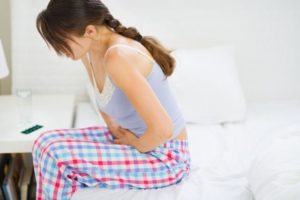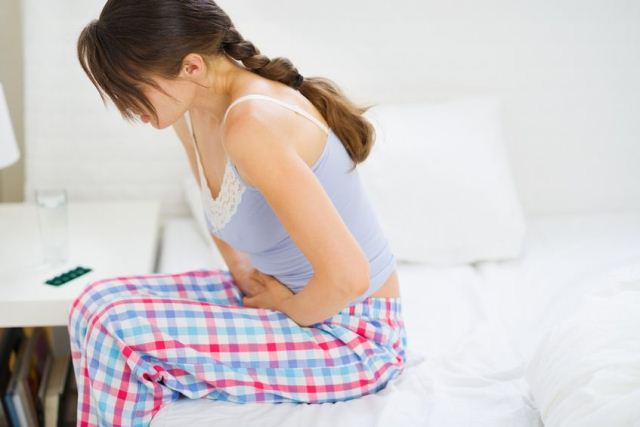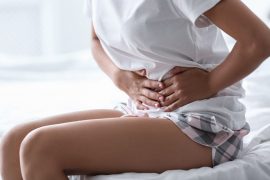By: Kathleen Doheny
More than half of women who menstruate report some pain from period cramps for a day or two each month, according to the American Congress of Obstetricians and Gynecologists. While menstrual cramps, also called dysmenorrhea, are usually not a sign of a serious health condition, they can put a crimp in your lifestyle.
To help with the pain, here are 10 things that may help. If your period cramps seem severe or you don’t get relief despite trying some of these options, check with your doctor to rule out more serious health issues.

- Improve Your Diet to Alleviate Period Cramps
Reducing fat and increasing vegetables in your diet may help ease monthly cramps. “A low-fat diet actually decreases overall levels of inflammation in the body,” says Aldo Palmieri MD, an ob/gyn at UCLA Health and professor of ob/gyn at the UCLA David Geffen School of Medicine in Los Angeles. A low-fat, vegetarian diet not only helps your health generally, says Dr. Palmieri, but it can have an indirect yet noticeable effect on menstrual cramps, too.
Trying to achieve a healthier diet? To start, swap out less healthy fats like the saturated fats found in animal products, and choose healthier ones like unsaturated fats found in olive oil, suggests the American Heart Association (AHA). If you are having dairy, pick low-fat or fat-free products. Overall, try to get 25 to 35 percent of your total daily calories from healthier fats found in fish, nuts, and vegetable oils, the AHA suggests. A balanced plate is essential; examples can be found at the healthy eating plate site from Harvard.
- Pop a Safe Painkiller
Not everyone wants to turn to medicine to soothe period cramps, but moderate use of a non-steroidal anti-inflammatory medication (NSAID), such as ibuprofen or naproxen, can help, Palmieri says. Menstrual cramps occur due to local release of substances called prostaglandins, he explains, and NSAIDs lower prostaglandin production and decrease overall inflammation and pain.
Check first with your doctor to be sure NSAIDs are a good choice for you, especially if you have a history of bleeding or kidney issues. And read the label for dosing instructions to be sure you don’t accidentally take too many.
- Turn to Tea to Calm Menstrual Cramps
Certain teas may help relieve menstrual cramps, says Sonya Angelone, RDN in the San Francisco Bay Area.
Research on herbal teas for menstrual pain relief is scarce, say experts, but teas have been used traditionally and can help. Because some of the herbs may act as estrogens, ask your doctor first before using one, especially if you have a history of a hormone-related cancer or take blood-thinning drugs.
One example of an herbal tea that people use for menstrual discomfort is cramp bark, according to the University of Maryland Medical Center. Boil 2 teaspoons of the bark in a cup of water, simmer for about 15 minutes, and drink it three times a day. Just clear this remedy with your doctor first, especially if you’re on diuretics for blood pressure or on lithium.
Tea with peppermint oil may also help, Angelone says. She advises her patients with cramps to start sipping the tea that gives them relief a week or so before they expect their period. Ask your doctor if that might work for you.
- Try Fish Oil and Vitamin B1
Another natural route to period cramp relief is taking fish oil supplements, vitamin B1, or both, according to research published in September 2014 in the Global Journal of Health Science. Scientists assigned 240 teens with menstrual cramps and other pain to take B1 and fish oil, B1 alone, fish oil alone, or a placebo. The teens took 100 milligrams (mg) per day of B1 and 500 mg daily of fish oil supplements.
When the teens reported their pain, those taking either the fish oil, B1, or both had significantly less pain than the placebo group. The pain also didn’t last as long if they took fish oil or B1.
- Needle Away Period Cramps
Acupuncture can help relieve cramps, says Jeannie Bianchi, a licensed acupuncturist in San Francisco. “We’re relaxing the nervous system,” she says, which causes more robust blood flow to the internal organs. The acupuncture is thought to have an anti-inflammatory effect.
In a January 2011 Cochrane review, experts looked at six studies that studied the effects of acupuncture on period cramps. They compared acupuncture with no treatment or conventional treatment (such as anti-inflammatory drugs) on 673 women. And in another four studies, they compared the effects of acupuncture versus no treatment or conventional treatment in 271 women.
Overall, they found that both acupuncture and acupressure could reduce pain, but concluded that more evaluation was needed to be sure.
- Massage with Essential Oils for Pain Relief
Using certain aromatic essential oils and massage can also relieve menstrual cramp pain, according to a study published in May 2012 in the Journal of Obstetrics and Gynaecology Research. Investigators assigned 48 women with menstrual cramps and other symptoms to massage either essential oils or a synthetic fragrance on their lower abdomen. The women used a mixture of diluted essential oils from the end of one period to the beginning of the next. Lavender, clary sage, and marjoram were used in a 2-1-1 ratio, and the essential oils were diluted to a 3 percent concentration overall in an unscented cream (a solution created, for example, by adding 3 milliliters (ml) of essential oils to 97 ml of an unscented cream).
Women in both groups reported less pain, but the essential oils group did better. Based on the women’s reports, researchers found that the duration of pain was reduced from 2.4 to 1.8 days after self-massaging with essential oils.
- Curl Up With a Heating Pad to Ease Period Cramps
“[Using] a heating pad has been studied, and it seems to work,” says Palmieri. In fact, one small study published in 2001 in Evidence-Based Nursing found that topically applied heat was just as effective as ibuprofen for period cramps. Examples of over-the-counter medicines containing ibuprofen include Advil and Motrin.
The researchers assigned 84 women who had cramps to one of four groups. One used a combination of a heated patch and ibuprofen (200 mg every 6 hours). A second group used an unheated (placebo) patch and ibuprofen. A third group used a heated patch and a placebo pill. A fourth group, the control, was given an unheated patch and a placebo pill.
Over the two study days, the women using heat plus ibuprofen, heat alone, and ibuprofen alone reported greater pain relief than those on the placebo. Women using heat with ibuprofen did not report differences in pain relief compared to those using ibuprofen alone. But with heat, they experienced faster improvement in pain relief: about 90 minutes after starting, compared to nearly three hours for those taking medicine alone. More women who used both heat and ibuprofen reported complete pain relief compared to those in the control group, the researchers found.
A review of studies published in March 2014 in the Journal of Physiotherapy found that heat reduced women’s period pain significantly.
- Boost Endorphins Your Way
In addition to their pain-relieving effect, endorphins can also boost your mood. Having an orgasm releases endorphins, Palmieri says, working out does as well. Perhaps the last thing you want to even think about while in the midst of cramps is exercise, but that can boost endorphins and help chase away pain.
- Increase the Magnesium in Your Diet
Getting more dietary magnesium seems to help ease the pain of cramps, says DeJarra Sims, ND, assistant professor of naturopathic medicine at Bastyr University’s California campus in San Diego and author of Your Healthiest Life Now. Indeed a Cochrane review of dietary and other remedies published in 2001 concluded that getting enough magnesium can help relieve pain.
Magnesium is found in many foods and as a supplement if you can’t get what you need from your diet. Magnesium helps regulate nerve and muscle functioning, among other vital tasks; researchers who evaluated the evidence on magnesium call it a promising treatment for menstrual cramps. But they cannot recommend a specific dose, because researchers have studied various doses. The recommended dietary allowance of magnesium for women of childbearing age is about 320 mg daily. An ounce of dry almonds or one half cup of boiled spinach each has about 80 mg.
- Lean on Your Contraceptive
The odds are that your birth control pills may help relieve painful cramps, as reported in a Cochrane review of 10 studies that was published in October 2009. Experts didn’t find any difference between low- or medium-dose estrogen contraceptives in producing pain relief for period cramps. But oral contraceptives come with side effects for some, which may include spotting, breast tenderness, nausea, and low sex drive — in addition to a higher risk of blood clots.
Source: everydayhealth.com




